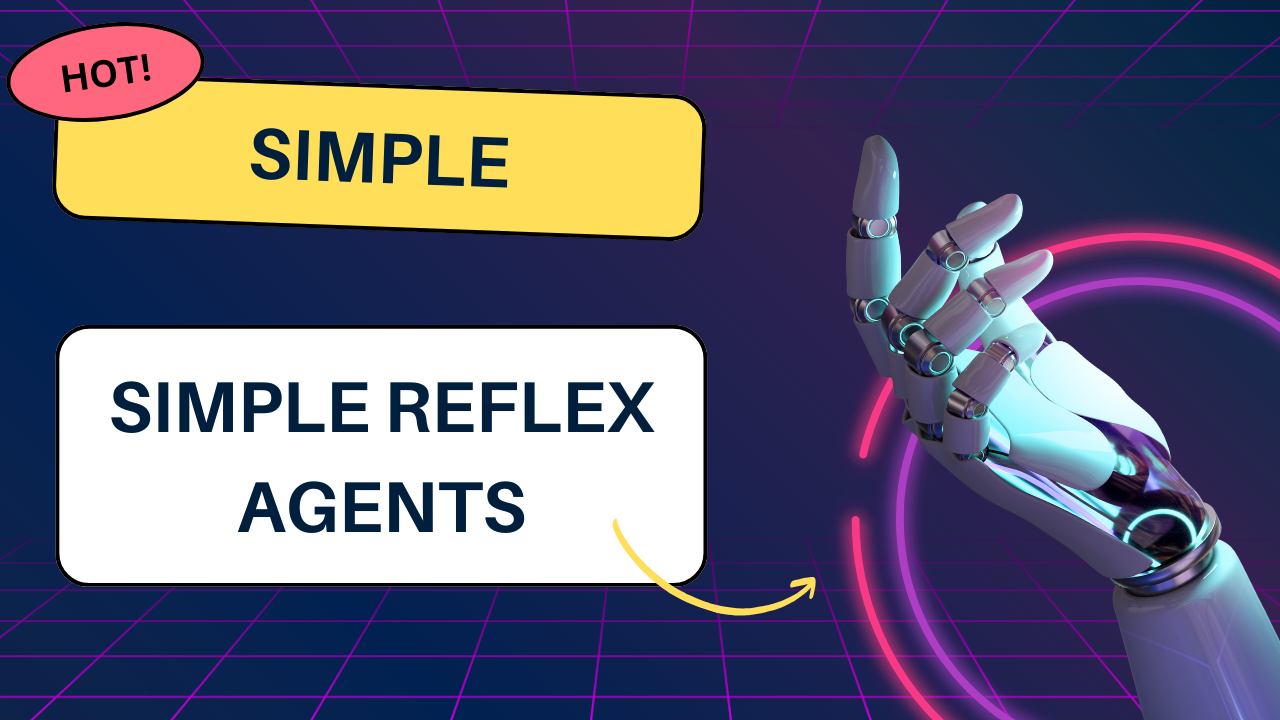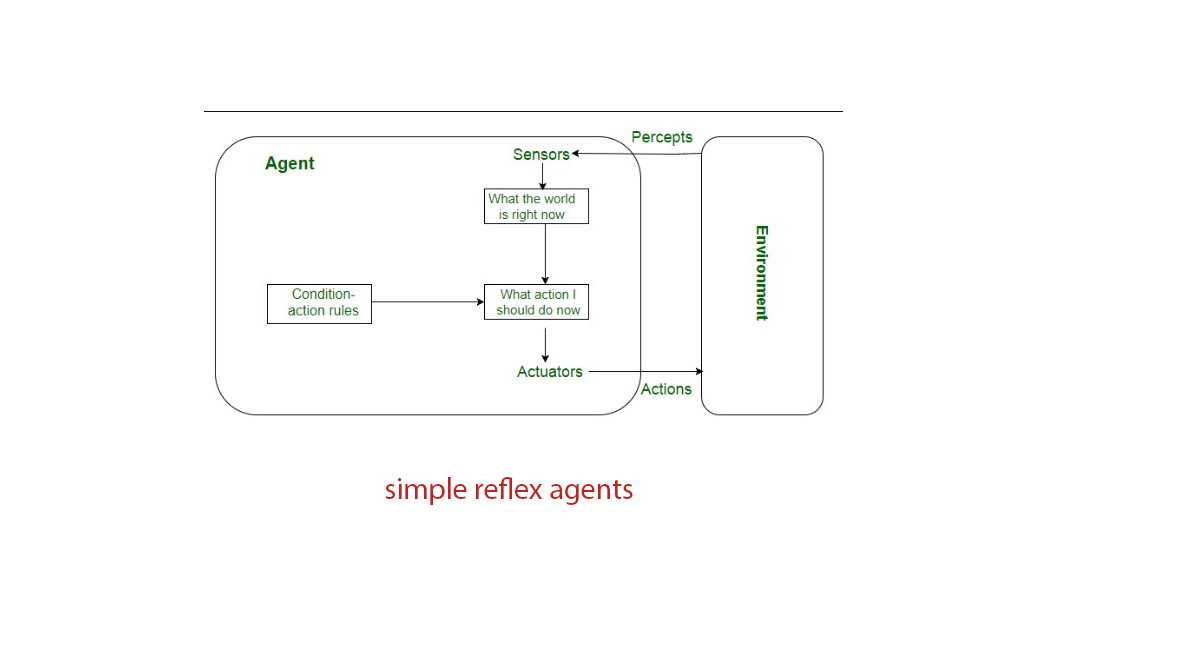simple reflex agents in ai

Types of agents in AI
-
Simple Reflex Agents = [fast work]
-
Model Based Reflex Agents
-
Goal Based Agents
-
Utility Based Agent
-
Learning Agents
simple reflex agents in ai
What is agents
It is the AI agent that helps them and gives you results.
AI agent performs all types of tasks in an engine, just like there are all types of tasks in an engine, how they will speed up or when they will get a break, all these tasks are determined.
simple reflex agents in ai
simple reflex agents
- work only on current situation/ Perception
- They ignore the history of previous State.
- follow condition. Action Rule.
- If condition true : do this,
“simple reflex agents in ai” work
- Act only on the basis of current perception
- Ignore the rest of percept history
- Based on If – Then Rules
- Environment should be fully observable.

Introduction simple reflex agents
- . A simple reflex agents in ai is a type of artificial intelligence agent that makes decisions based solely on the current percept, which is the agent’s current sensory input. It doesn’t take into account the history of past percepts or future consequences of its actions. simple reflex agents in ai operate using condition-action rules, where each rule specifies an action to be taken in response to a specific percept or sensory input.
- In essence, these agents are designed to react in a fixed and predefined way to specific situations. They are simple and limited in their problem-solving capabilities because they don’t have the ability to consider the broader context or plan for the future. Their decision-making process is solely determined by the percept they receive at a given moment.
simple reflex agents feature
A simple reflex agents in ai is a type of artificial intelligence (AI) agent that operates based on a set of predefined rules or condition-action pairs. These agents are typically used in environments with a limited range of possible actions and well-defined, static states. Here are some key features of simple reflex agents in ai
- Limited Sensing: simple reflex agents in ai have limited sensing capabilities. They can only perceive a small portion of their environment, typically through sensors or sensors that capture specific aspects of the environment.
- Condition-Action Rules: These agents rely on a set of predefined condition-action rules. When they sense a specific condition in the environment, they immediately perform a corresponding action. These rules are designed based on the agent’s programming and are often represented as “if-then” statements.
- Lack of Memory: simple reflex agents in ai do not have memory or the ability to retain information about past states or actions. They make decisions solely based on the current sensory input and the programmed rules.
- Deterministic: Their actions are deterministic, meaning that given the same set of sensory input and rules, they will always produce the same output or action. There is no element of randomness or learning involved.
- Limited Applicability: simple reflex agents in ai are suitable for environments where actions can be determined solely by the current state and the provided rules. They are not well-suited for dynamic or complex environments where a more sophisticated decision-making process is required.
- Efficiency: These agents are generally computationally efficient because they make quick, rule-based decisions without the need for complex reasoning or planning.
- Vulnerability: simple reflex agents in ai are vulnerable to unexpected changes or uncertainties in their environment. If the predefined rules do not cover all possible scenarios, the agent may make incorrect decisions.
Limitations simple reflex agents :-
- Very limited intelligence e current
- For Non-perceptual part of state = current no knowledge
- Limited Context: These agents can only make decisions based on the current percept and do not consider the history of past percepts. They lack the ability to take into account the broader context or anticipate future events.
- Rigidity: Simple reflex agents operate based on fixed condition-action rules. If the rules don’t cover a particular situation, they cannot adapt or make informed decisions. They are inflexible and not adaptable.
- No Learning: These agents do not possess the ability to learn from experience. They cannot improve their decision-making over time or adapt to changing environments.
- Lack of Goal-Directed Behavior: Simple reflex agents do not have the capacity to pursue specific goals. They react to stimuli but cannot engage in purposeful, goal-oriented behavior.
- Vulnerability to Changes: These agents are highly sensitive to changes in their environment. If the environment changes in a way not covered by their rules, they may make incorrect decisions.
- Inefficient for Complex Tasks: They are not suitable for solving complex problems that require a deep understanding of the environment and a consideration of long-term consequences.
- Simple reflex agents are primarily used in very basic and straightforward tasks where a fixed, rule-based response is sufficient. In more complex and dynamic environments, more sophisticated AI systems with higher levels of reasoning and adaptability are required.
-
simple reflex agents examples
- Thermostat: A basic thermostat in a heating or cooling system is a simple reflex agent. It senses the current temperature (percept) and takes actions based on predefined rules, such as turning on the heating if the temperature falls below a certain threshold.
- Automatic Door Sensor: Sensors in automatic doors at supermarkets or airports are simple reflex agents. They detect the presence of a person (percept) and trigger the door to open in response.
- Elevator Floor Selection: Elevator systems in some buildings use simple reflex agents to determine which floor the elevator should go to next. They consider the current floor and the buttons pressed by passengers as percepts to make a decision.
- Traffic Light Control: Traffic lights can be considered simple reflex agents. They change signals based on predefined rules and the current state of traffic (percepts) at an intersection.
- Washing Machine: Many washing machines have simple reflex agents for certain functions. For instance, they may sense the water level or laundry load weight (percepts) and adjust the washing cycle accordingly.
- Automated Sprinkler System: Some automated sprinkler systems for watering lawns or gardens operate as simple reflex agents. They respond to environmental factors like soil moisture (percepts) to determine when and how much to water.
The Role of Simple Reflex Agents in Everyday Life
Simple reflex agents play a significant role in our daily lives, providing us with convenience and automation. From automatic doors at the supermarket to the thermostat that keeps our homes comfortable, these agents make life more manageable.
How Simple Reflex Agents Differ from Advanced AI
While simple reflex agents are effective in specific contexts, they differ greatly from advanced AI systems. The latter can learn, reason, and make decisions based on a broad range of data, adapting to diverse scenarios.
The Advantages of Simplicity
The simplicity of simple reflex agents can be an advantage in situations where quick and predictable responses are needed. In applications like safety systems, their straightforward decision-making process is advantageous.
Challenges in Complex Environments
Simple reflex agents are not suitable for complex tasks that require a deep understanding of the environment and consideration of long-term consequences. Their limitations become apparent in dynamic, multifaceted settings.
Real-World Applications
These agents find applications in various fields, including industrial automation, home appliances, and certain aspects of robotics. Their reliability and predictability make them valuable in specific situations.
The Future of Simple Reflex Agents
As technology advances, simple reflex agents may become even more integrated into our lives. Their role in automating routine tasks will likely persist, while more advanced AI systems tackle complex problems.
Conclusion
Simple reflex agents are the unsung heroes of automation and convenience in our modern world. While they have limitations, their role in making everyday processes more manageable cannot be overstated. As we continue to innovate, finding a balance between simplicity and complexity in AI will be key to shaping a more efficient and automated future.
Frequently Asked Questions (FAQs)
1. What is the primary characteristic of simple reflex agents?
Simple reflex agents make decisions based solely on the current percept or sensory input at any given moment.
2. Can simple reflex agents adapt to new situations?
No, simple reflex agents operate based on fixed condition-action rules and cannot adapt to new or unforeseen situations.
3. What are some examples of simple reflex agents in everyday life?
Examples include thermostats, automatic door sensors, and traffic lights.
4. How do simple reflex agents differ from advanced AI systems?
Simple reflex agents lack the ability to learn, reason, and adapt to a wide range of situations, whereas advanced AI systems can.
5. What is the future outlook for simple reflex agents?
As technology advances, simple reflex agents will continue to play a role in automating routine tasks, while advanced AI systems handle complex challenges.
Smart speaker with Alexa (Blue) buy now Virtual assistants: smart ai
simple reflex agents in ai
what is an intelligent agent in ai
what is artificial intelligence composed of – ai
43 goals ai – future goals of ai – ankul belhi
36 ai features – what is artificial intelligence features
Ai history in legal advice -ai history filter -Foundational Concepts of AI
simple reflex agents in ai
what is AI // क्या है ai //type of ai
Reinforcement learning- (RL)-What is RL in reinforcement?-introduction